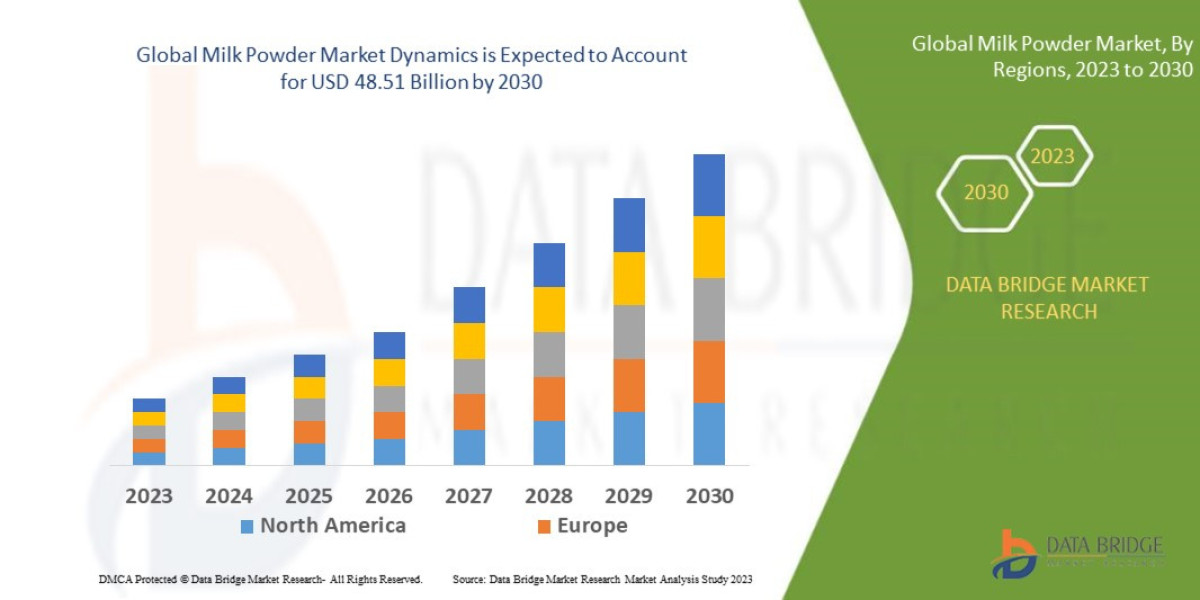Executive Summary
Data Bridge Market Research analyses that the global milk powder market which was USD 35.17 billion in 2022, is expected to reach USD 48.51 billion by 2030, and is expected to undergo a CAGR of 4.10% during the forecast period of 2023 to 2030.
Market Overview
The Milk Powder Market is defined by the transformation of fluid milk into a long-shelf-life, transportable, and highly functional ingredient via spray drying. The primary differentiation lies in fat content and functional properties.
Key Segments by Product Type
Skim Milk Powder (SMP) (Largest Volume Segment): Contains less than 1.5% fat. Highly valued for its protein content, making it crucial in bakery, confectionery, and functional food applications where fat is not desired.
Whole Milk Powder (WMP) (Largest Value Segment): Typically contains 26% to 40% fat. Dominant in consumer retail markets, beverages, and infant formula, valued for its creamy texture and flavor profile.
Dairy Ingredients (Specialty Segment): Includes specialized forms like Buttermilk Powder (BMP), Whey Protein Concentrate (WPC), and Milk Protein Concentrate (MPC). These are high-value, functional ingredients driven by the sports and clinical nutrition segments.
Key Segments by Application
Infant Formula and Nutrition (Highest Value Segment): Driven by stringent quality requirements and non-negotiable demand for high-quality protein and nutrients.
Confectionery and Bakery: Used for improving texture, shelf life, and color in products like chocolate and biscuits.
Nutritional and Sports Beverages: Utilizing high-protein SMP and specialized whey derivatives.
Retail/Household Consumption: Direct use of WMP in developing markets and as a general dairy substitute.
Drivers and Current Dynamics
Core Market Drivers:
Demand for Infant Nutrition: Rapid population growth and urbanization, especially across Asia, fuel non-negotiable demand for consistent, safe milk powder for infant formula manufacturing.
Logistical Efficiency: Milk powder's extended shelf life and low bulk density make it the most economical way to supply dairy nutrition to deficit regions, insulating trade from short-term liquid milk supply disruptions.
Functional Food Penetration: Increasing awareness of protein intake drives demand for concentrated milk protein ingredients (MPC, WPC) in health and wellness products.
Current Dynamics: The market is characterized by intense price volatility, with global supply (largely from New Zealand, the EU, and the US) sensitive to weather patterns and regulatory changes, while demand from major importers (like China and Southeast Asia) can shift quickly, impacting commodity benchmarks.
Market Size & Forecast
Data Bridge Market Research analyses that the global milk powder market which was USD 35.17 billion in 2022, is expected to reach USD 48.51 billion by 2030, and is expected to undergo a CAGR of 4.10% during the forecast period of 2023 to 2030..
For More Information visit https://www.databridgemarketresearch.com/reports/global-milk-powder-market
Key Trends & Innovations
Innovation in the milk powder sector focuses on improving functional properties, stability, and meeting stringent clean label and quality demands.
1. Advanced Agglomeration and Instantization
Improving the solubility and wettability of milk powder is crucial for consumers and industrial users. Manufacturers are adopting advanced agglomeration and lecithination processes to create "instant" powders that dissolve quickly in cold liquids, reducing caking and improving user experience in beverages and reconstitution.
2. Traceability and Quality Assurance Technology
Given the high-stakes nature of the infant formula segment, blockchain and enhanced digital traceability are becoming standard. This allows brands to track the entire supply chain, from the farm gate to the final processing plant, ensuring verifiable quality, safety, and provenance, which is a major competitive differentiator.
3. Protein Fortification and Functionality
There is a growing trend to use high-protein milk powders (e.g., MPC 80) to develop functional dairy products with specific health claims, such as satiety, muscle recovery, and bone health. Innovation centers on manipulating protein structure to optimize emulsification and thermal stability in specialized food applications.
4. Sustainable Dairy Sourcing and Carbon Footprint
Major buyers are increasingly requiring verification of sustainable dairy farming practices from their suppliers. This drives investment in methane-reducing feed additives, energy-efficient drying facilities, and farm-level resource management to produce "low-carbon footprint" milk powder, which commands a premium.
Competitive Landscape
The market is characterized by strong global consolidation among major dairy cooperatives and multinational food companies that control vast milk supplies and specialized processing technologies.
Major Players and Strategic Strategies
Global Dairy Cooperatives (e.g., Fonterra (New Zealand), FrieslandCampina (Netherlands)): Their strategy is Supply Chain Dominance and Global Trading Scale. They leverage their massive milk pools and global logistics networks to set commodity price benchmarks and ensure constant supply across multiple continents.
**Multinational Food/Nutrition Giants (e.ucial for consumers and industrial users. Manufacturers are adopting
Browse More Reports:
North America Plant Based Protein Market
Global Radiotheranostics Market
Europe Small Molecule Sterile Injectable Drugs Market
Global Tachycardia Drugs Market
Global Terminal Automation Market
Global Pipeline Transportation Market
North America Polyimide Films Market
Global Propylene Glycol Market
Global Electric Heat Tracing (EHT) Market
Global Digital Assistant Market
Europe Molded Plastics Market
Global Individual Quick Freezing (IQF) Meat and Poultry Market
Global Internet of Things (IoT) Node and Gateway Market
Global Idiopathic Intracranial Hypertension Treatment Market
Global Blast Chillers Market
North America Testing, Inspection, and Certification (TIC) Market for Building and Construction – Industry Trends and Forecast to 2028
Middle East and Africa Food Bags Market
Latin America Rotomolding Market
Global Automotive Energy Absorption (EA) Pads Market
Europe Methylene Diphenyl Diisocyanate (MDI) Toluene Diisocyanate (TDI) and Polyurethane Market
Global Doors Market
Global Insulation Coating Materials Market
Europe Acute Lymphocytic/Lymphoblastic Leukemia (ALL) Diagnostics Market
Global Cercarial Dermatitis Market
Global X-Ray Fluorescence Analyser Market
Middle East and Africa IoT Node and Gateway Market
Global Blood Meal Market
Global Two Part Adhesive Market
Middle East and Africa Potato Processing Market
Europe Indium Market
North America Probe Card Market
About Data Bridge Market Research:
An absolute way to forecast what the future holds is to comprehend the trend today!
Data Bridge Market Research set forth itself as an unconventional and neoteric market research and consulting firm with an unparalleled level of resilience and integrated approaches. We are determined to unearth the best market opportunities and foster efficient information for your business to thrive in the market. Data Bridge endeavors to provide appropriate solutions to the complex business challenges and initiates an effortless decision-making process. Data Bridge is an aftermath of sheer wisdom and experience which was formulated and framed in the year 2015 in Pune.
Contact Us:
Data Bridge Market Research
US: +1 614 591 3140
UK: +44 845 154 9652
APAC : +653 1251 975
Email:- corporatesales@databridgemarketresearch.com








